Financial Accounting (ACC701): AASB 138 Report - KOI - T119
VerifiedAdded on 2023/03/20
|13
|2731
|29
Report
AI Summary
This report meticulously examines the application of AASB 138, focusing on the accounting treatment of intangible assets within the context of Technology Enterprises Ltd. It begins with an introduction to the standard, emphasizing its role in ensuring accurate financial reporting. The report then addresses key questions regarding the recognition of intangible assets, differentiating between research and development phases, and determining the appropriate cost. A detailed analysis of the case study reveals the correct accounting for internally generated intangible assets, including the capitalization of specific costs and the exclusion of others, in alignment with AASB 138 provisions. Furthermore, it compares and contrasts AASB 138 and IAS 38, highlighting their similarities and the importance of management judgment. The report also analyzes the CEO's perspective on market hypotheses and provides recommendations to address investor concerns. Finally, it concludes by summarizing the significance of AASB 138 in fostering transparency and ensuring the true and fair value of assets.
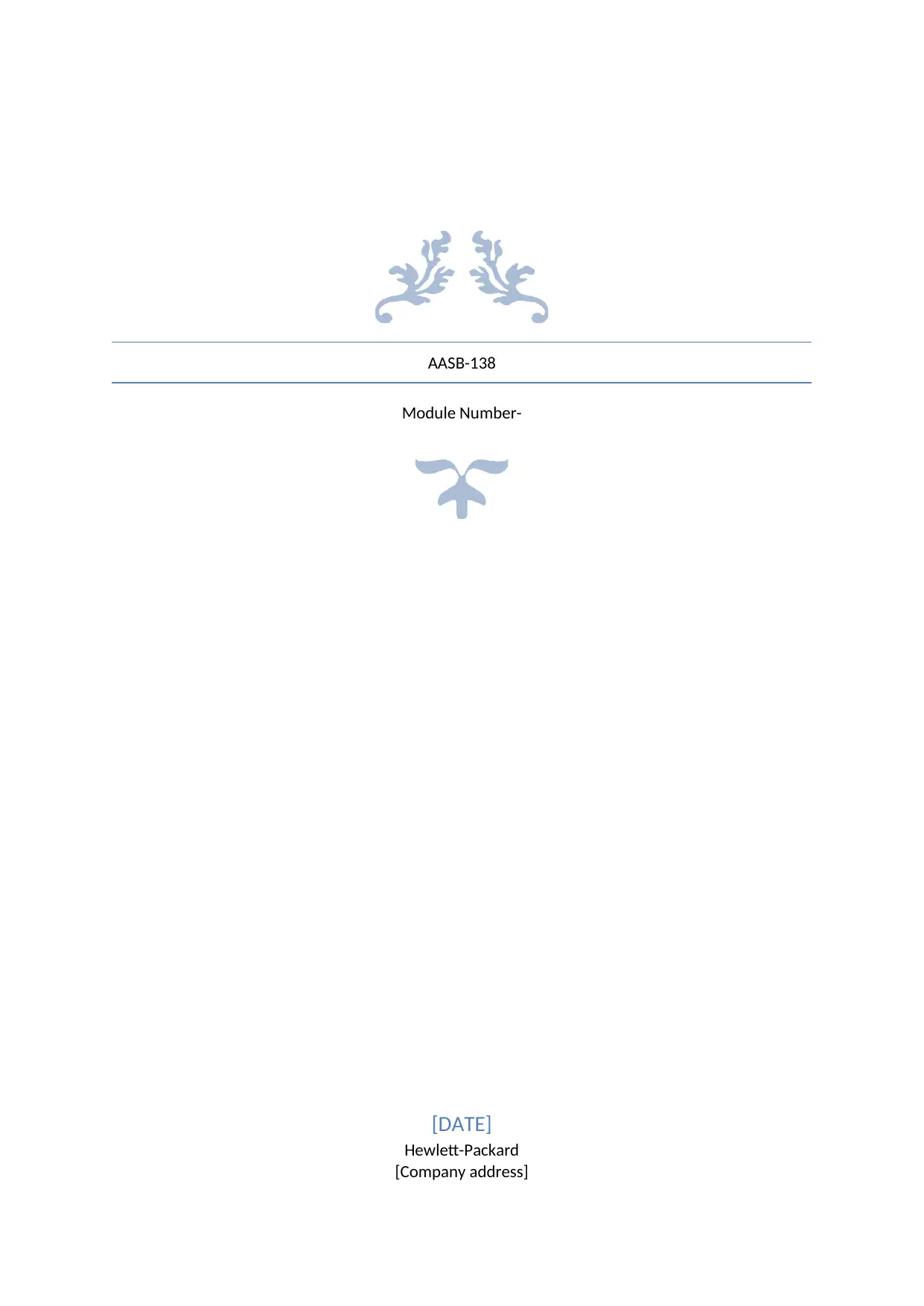
AASB-138
Module Number-
[DATE]
Hewlett-Packard
[Company address]
Module Number-
[DATE]
Hewlett-Packard
[Company address]
Paraphrase This Document
Need a fresh take? Get an instant paraphrase of this document with our AI Paraphraser
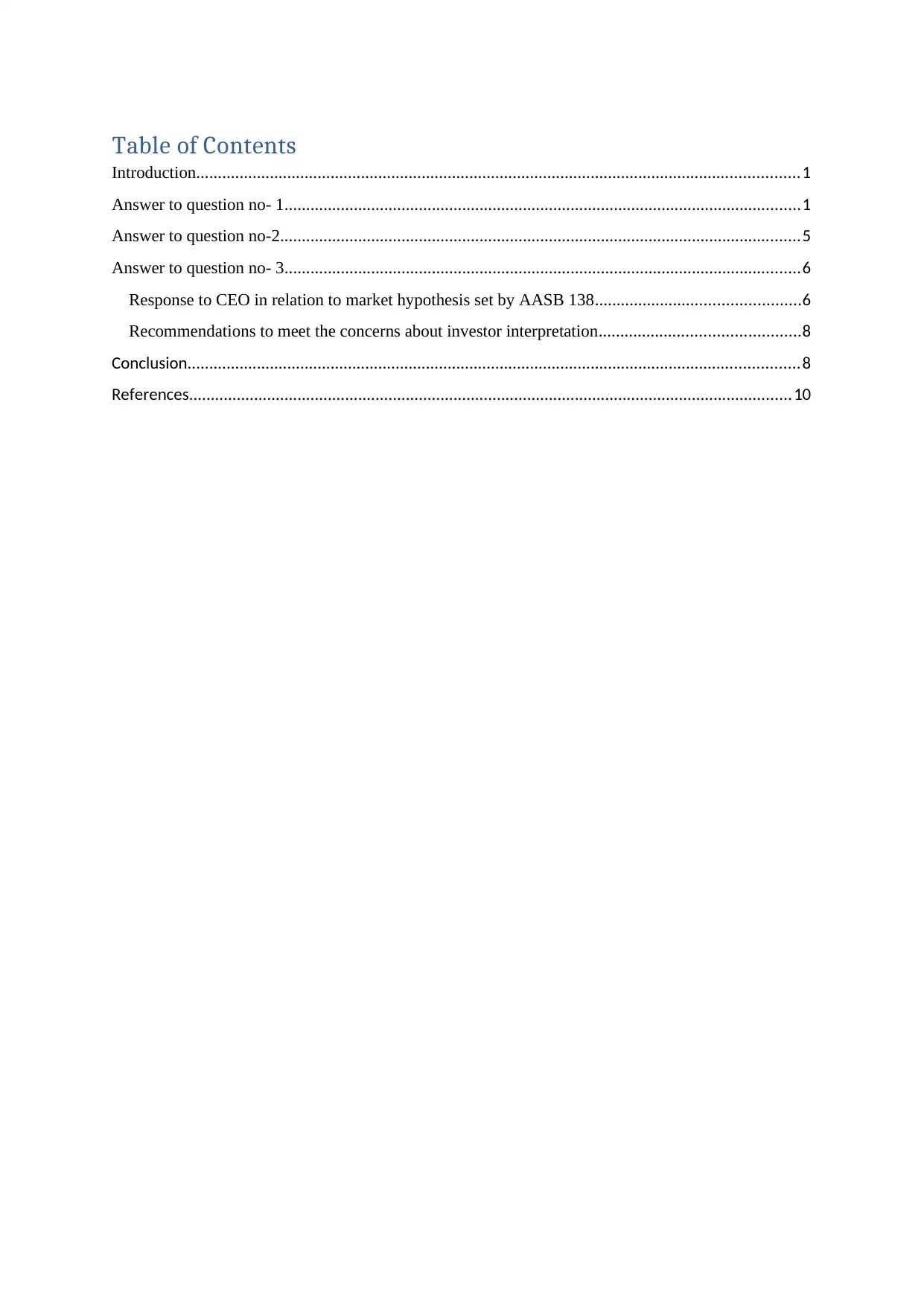
Table of Contents
Introduction...........................................................................................................................................1
Answer to question no- 1.......................................................................................................................1
Answer to question no-2........................................................................................................................5
Answer to question no- 3.......................................................................................................................6
Response to CEO in relation to market hypothesis set by AASB 138...............................................6
Recommendations to meet the concerns about investor interpretation..............................................8
Conclusion.............................................................................................................................................8
References...........................................................................................................................................10
Introduction...........................................................................................................................................1
Answer to question no- 1.......................................................................................................................1
Answer to question no-2........................................................................................................................5
Answer to question no- 3.......................................................................................................................6
Response to CEO in relation to market hypothesis set by AASB 138...............................................6
Recommendations to meet the concerns about investor interpretation..............................................8
Conclusion.............................................................................................................................................8
References...........................................................................................................................................10
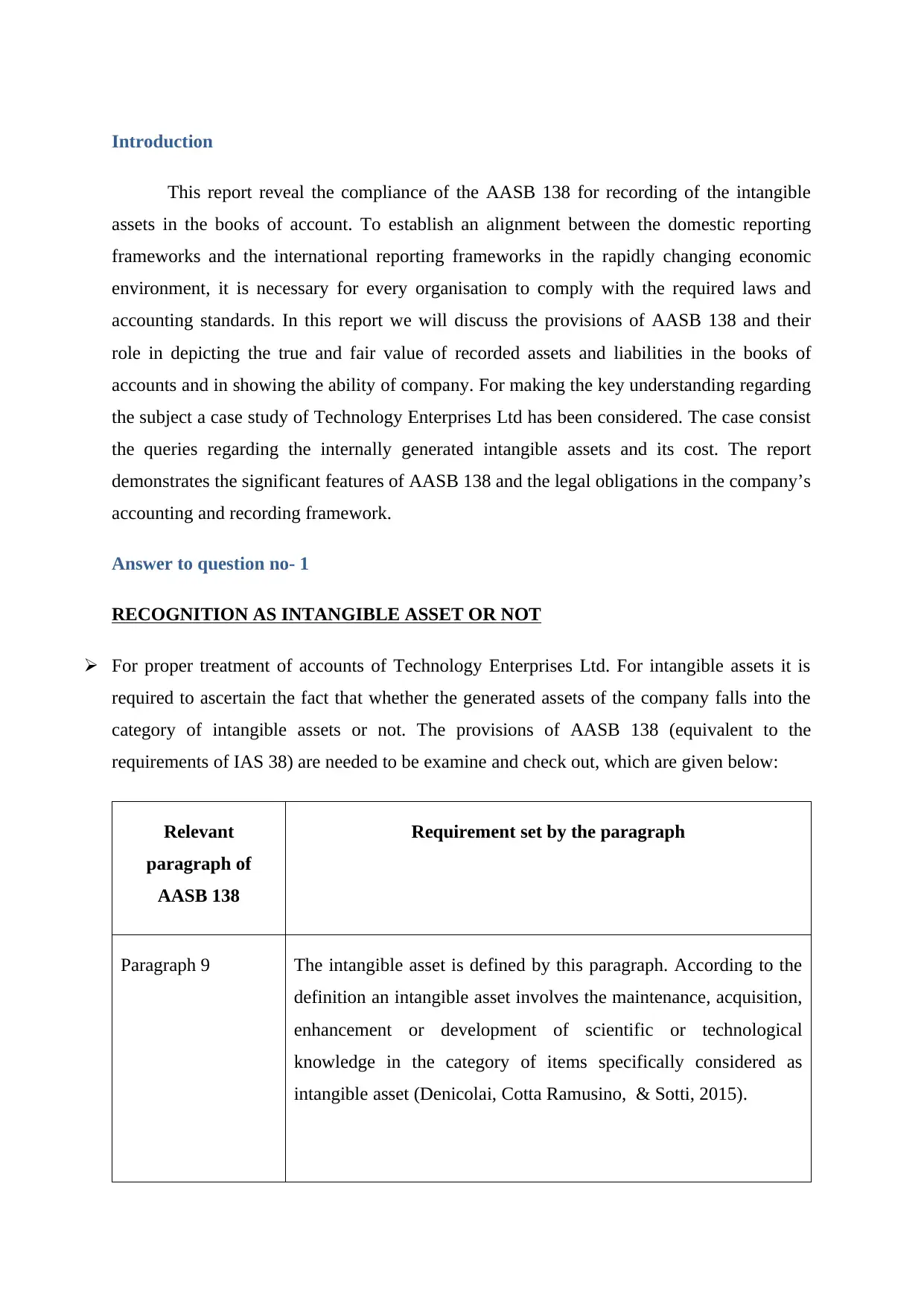
Introduction
This report reveal the compliance of the AASB 138 for recording of the intangible
assets in the books of account. To establish an alignment between the domestic reporting
frameworks and the international reporting frameworks in the rapidly changing economic
environment, it is necessary for every organisation to comply with the required laws and
accounting standards. In this report we will discuss the provisions of AASB 138 and their
role in depicting the true and fair value of recorded assets and liabilities in the books of
accounts and in showing the ability of company. For making the key understanding regarding
the subject a case study of Technology Enterprises Ltd has been considered. The case consist
the queries regarding the internally generated intangible assets and its cost. The report
demonstrates the significant features of AASB 138 and the legal obligations in the company’s
accounting and recording framework.
Answer to question no- 1
RECOGNITION AS INTANGIBLE ASSET OR NOT
For proper treatment of accounts of Technology Enterprises Ltd. For intangible assets it is
required to ascertain the fact that whether the generated assets of the company falls into the
category of intangible assets or not. The provisions of AASB 138 (equivalent to the
requirements of IAS 38) are needed to be examine and check out, which are given below:
Relevant
paragraph of
AASB 138
Requirement set by the paragraph
Paragraph 9 The intangible asset is defined by this paragraph. According to the
definition an intangible asset involves the maintenance, acquisition,
enhancement or development of scientific or technological
knowledge in the category of items specifically considered as
intangible asset (Denicolai, Cotta Ramusino, & Sotti, 2015).
This report reveal the compliance of the AASB 138 for recording of the intangible
assets in the books of account. To establish an alignment between the domestic reporting
frameworks and the international reporting frameworks in the rapidly changing economic
environment, it is necessary for every organisation to comply with the required laws and
accounting standards. In this report we will discuss the provisions of AASB 138 and their
role in depicting the true and fair value of recorded assets and liabilities in the books of
accounts and in showing the ability of company. For making the key understanding regarding
the subject a case study of Technology Enterprises Ltd has been considered. The case consist
the queries regarding the internally generated intangible assets and its cost. The report
demonstrates the significant features of AASB 138 and the legal obligations in the company’s
accounting and recording framework.
Answer to question no- 1
RECOGNITION AS INTANGIBLE ASSET OR NOT
For proper treatment of accounts of Technology Enterprises Ltd. For intangible assets it is
required to ascertain the fact that whether the generated assets of the company falls into the
category of intangible assets or not. The provisions of AASB 138 (equivalent to the
requirements of IAS 38) are needed to be examine and check out, which are given below:
Relevant
paragraph of
AASB 138
Requirement set by the paragraph
Paragraph 9 The intangible asset is defined by this paragraph. According to the
definition an intangible asset involves the maintenance, acquisition,
enhancement or development of scientific or technological
knowledge in the category of items specifically considered as
intangible asset (Denicolai, Cotta Ramusino, & Sotti, 2015).
⊘ This is a preview!⊘
Do you want full access?
Subscribe today to unlock all pages.

Trusted by 1+ million students worldwide
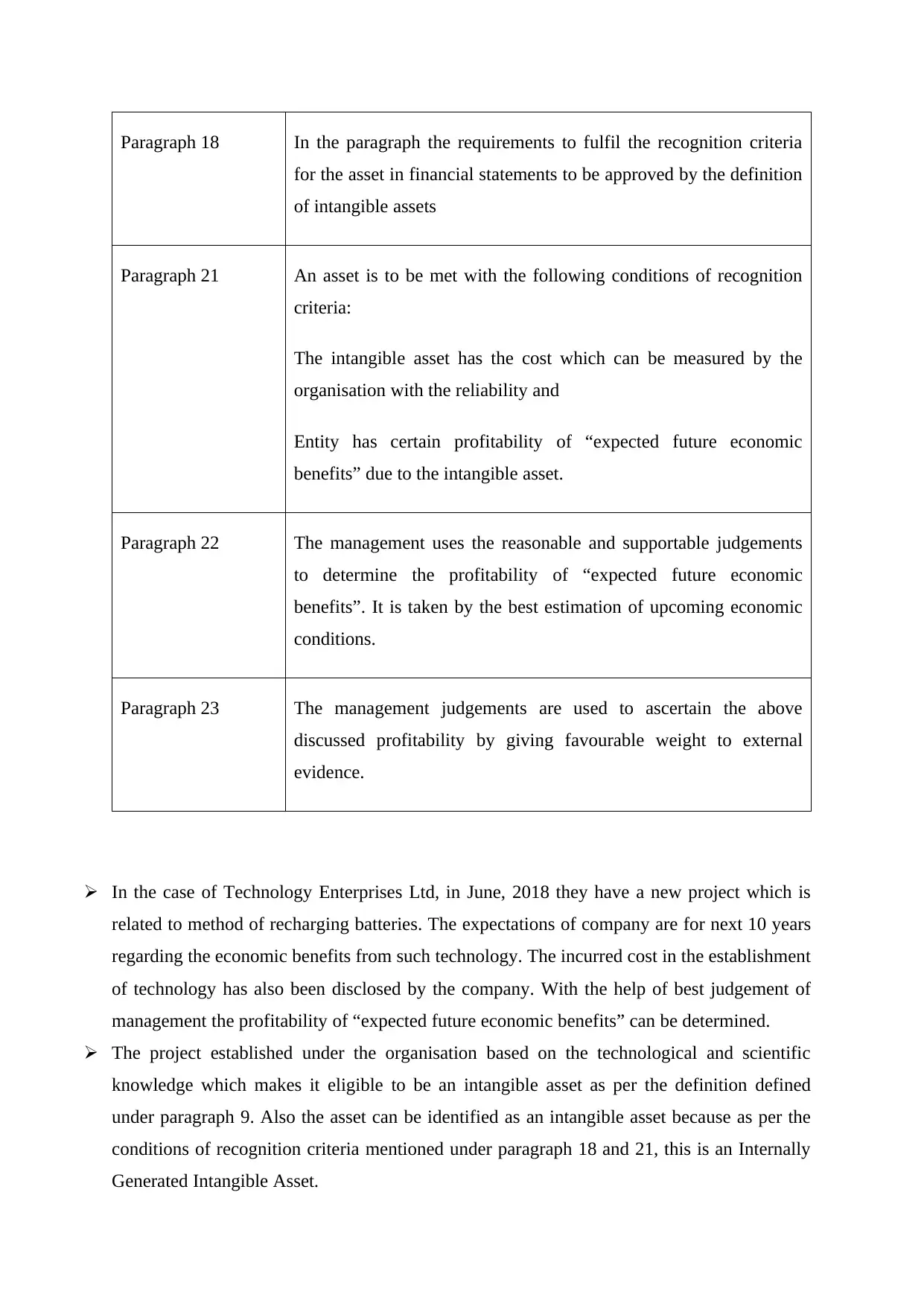
Paragraph 18 In the paragraph the requirements to fulfil the recognition criteria
for the asset in financial statements to be approved by the definition
of intangible assets
Paragraph 21 An asset is to be met with the following conditions of recognition
criteria:
The intangible asset has the cost which can be measured by the
organisation with the reliability and
Entity has certain profitability of “expected future economic
benefits” due to the intangible asset.
Paragraph 22 The management uses the reasonable and supportable judgements
to determine the profitability of “expected future economic
benefits”. It is taken by the best estimation of upcoming economic
conditions.
Paragraph 23 The management judgements are used to ascertain the above
discussed profitability by giving favourable weight to external
evidence.
In the case of Technology Enterprises Ltd, in June, 2018 they have a new project which is
related to method of recharging batteries. The expectations of company are for next 10 years
regarding the economic benefits from such technology. The incurred cost in the establishment
of technology has also been disclosed by the company. With the help of best judgement of
management the profitability of “expected future economic benefits” can be determined.
The project established under the organisation based on the technological and scientific
knowledge which makes it eligible to be an intangible asset as per the definition defined
under paragraph 9. Also the asset can be identified as an intangible asset because as per the
conditions of recognition criteria mentioned under paragraph 18 and 21, this is an Internally
Generated Intangible Asset.
for the asset in financial statements to be approved by the definition
of intangible assets
Paragraph 21 An asset is to be met with the following conditions of recognition
criteria:
The intangible asset has the cost which can be measured by the
organisation with the reliability and
Entity has certain profitability of “expected future economic
benefits” due to the intangible asset.
Paragraph 22 The management uses the reasonable and supportable judgements
to determine the profitability of “expected future economic
benefits”. It is taken by the best estimation of upcoming economic
conditions.
Paragraph 23 The management judgements are used to ascertain the above
discussed profitability by giving favourable weight to external
evidence.
In the case of Technology Enterprises Ltd, in June, 2018 they have a new project which is
related to method of recharging batteries. The expectations of company are for next 10 years
regarding the economic benefits from such technology. The incurred cost in the establishment
of technology has also been disclosed by the company. With the help of best judgement of
management the profitability of “expected future economic benefits” can be determined.
The project established under the organisation based on the technological and scientific
knowledge which makes it eligible to be an intangible asset as per the definition defined
under paragraph 9. Also the asset can be identified as an intangible asset because as per the
conditions of recognition criteria mentioned under paragraph 18 and 21, this is an Internally
Generated Intangible Asset.
Paraphrase This Document
Need a fresh take? Get an instant paraphrase of this document with our AI Paraphraser
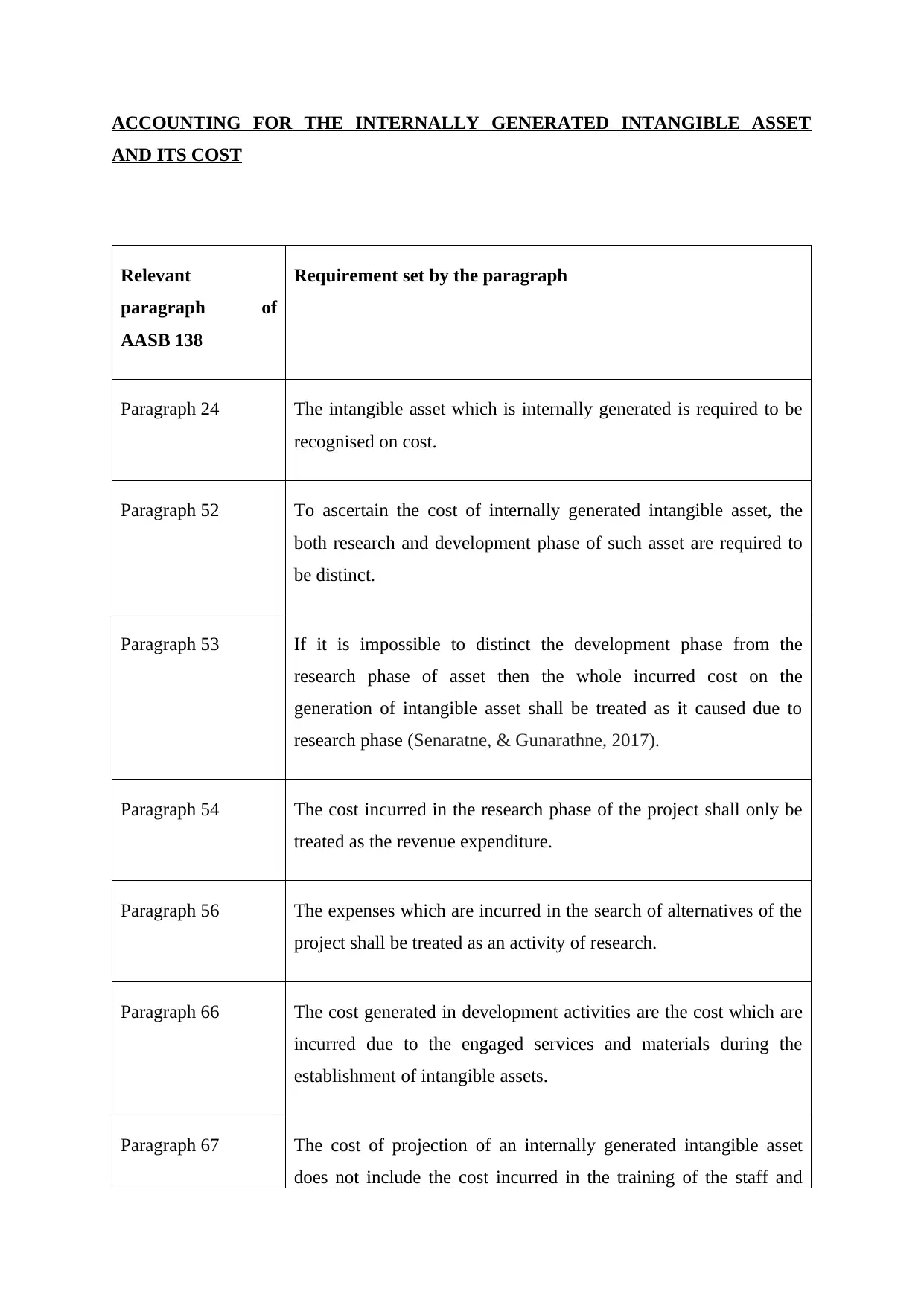
ACCOUNTING FOR THE INTERNALLY GENERATED INTANGIBLE ASSET
AND ITS COST
Relevant
paragraph of
AASB 138
Requirement set by the paragraph
Paragraph 24 The intangible asset which is internally generated is required to be
recognised on cost.
Paragraph 52 To ascertain the cost of internally generated intangible asset, the
both research and development phase of such asset are required to
be distinct.
Paragraph 53 If it is impossible to distinct the development phase from the
research phase of asset then the whole incurred cost on the
generation of intangible asset shall be treated as it caused due to
research phase (Senaratne, & Gunarathne, 2017).
Paragraph 54 The cost incurred in the research phase of the project shall only be
treated as the revenue expenditure.
Paragraph 56 The expenses which are incurred in the search of alternatives of the
project shall be treated as an activity of research.
Paragraph 66 The cost generated in development activities are the cost which are
incurred due to the engaged services and materials during the
establishment of intangible assets.
Paragraph 67 The cost of projection of an internally generated intangible asset
does not include the cost incurred in the training of the staff and
AND ITS COST
Relevant
paragraph of
AASB 138
Requirement set by the paragraph
Paragraph 24 The intangible asset which is internally generated is required to be
recognised on cost.
Paragraph 52 To ascertain the cost of internally generated intangible asset, the
both research and development phase of such asset are required to
be distinct.
Paragraph 53 If it is impossible to distinct the development phase from the
research phase of asset then the whole incurred cost on the
generation of intangible asset shall be treated as it caused due to
research phase (Senaratne, & Gunarathne, 2017).
Paragraph 54 The cost incurred in the research phase of the project shall only be
treated as the revenue expenditure.
Paragraph 56 The expenses which are incurred in the search of alternatives of the
project shall be treated as an activity of research.
Paragraph 66 The cost generated in development activities are the cost which are
incurred due to the engaged services and materials during the
establishment of intangible assets.
Paragraph 67 The cost of projection of an internally generated intangible asset
does not include the cost incurred in the training of the staff and
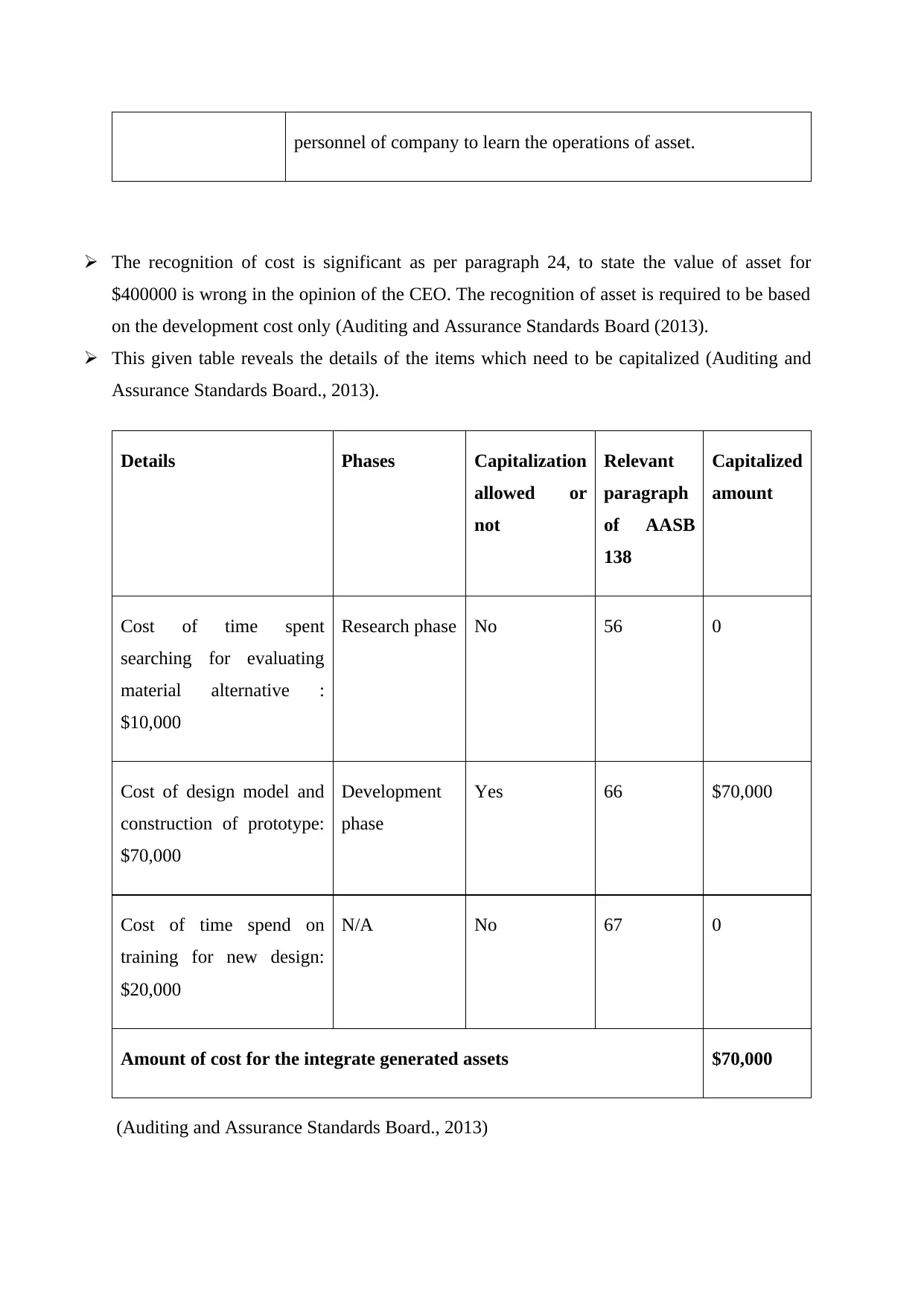
personnel of company to learn the operations of asset.
The recognition of cost is significant as per paragraph 24, to state the value of asset for
$400000 is wrong in the opinion of the CEO. The recognition of asset is required to be based
on the development cost only (Auditing and Assurance Standards Board (2013).
This given table reveals the details of the items which need to be capitalized (Auditing and
Assurance Standards Board., 2013).
Details Phases Capitalization
allowed or
not
Relevant
paragraph
of AASB
138
Capitalized
amount
Cost of time spent
searching for evaluating
material alternative :
$10,000
Research phase No 56 0
Cost of design model and
construction of prototype:
$70,000
Development
phase
Yes 66 $70,000
Cost of time spend on
training for new design:
$20,000
N/A No 67 0
Amount of cost for the integrate generated assets $70,000
(Auditing and Assurance Standards Board., 2013)
The recognition of cost is significant as per paragraph 24, to state the value of asset for
$400000 is wrong in the opinion of the CEO. The recognition of asset is required to be based
on the development cost only (Auditing and Assurance Standards Board (2013).
This given table reveals the details of the items which need to be capitalized (Auditing and
Assurance Standards Board., 2013).
Details Phases Capitalization
allowed or
not
Relevant
paragraph
of AASB
138
Capitalized
amount
Cost of time spent
searching for evaluating
material alternative :
$10,000
Research phase No 56 0
Cost of design model and
construction of prototype:
$70,000
Development
phase
Yes 66 $70,000
Cost of time spend on
training for new design:
$20,000
N/A No 67 0
Amount of cost for the integrate generated assets $70,000
(Auditing and Assurance Standards Board., 2013)
⊘ This is a preview!⊘
Do you want full access?
Subscribe today to unlock all pages.

Trusted by 1+ million students worldwide
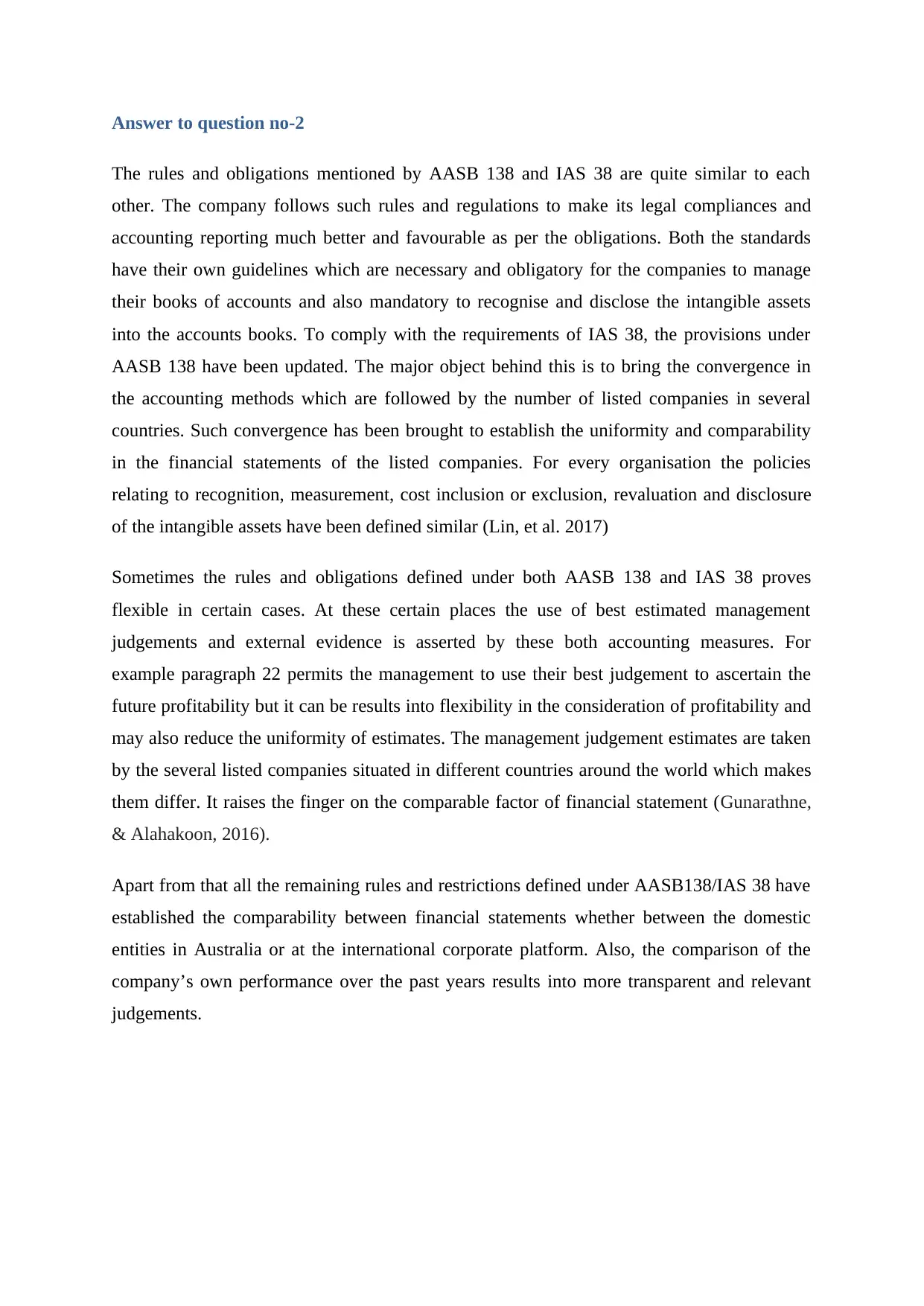
Answer to question no-2
The rules and obligations mentioned by AASB 138 and IAS 38 are quite similar to each
other. The company follows such rules and regulations to make its legal compliances and
accounting reporting much better and favourable as per the obligations. Both the standards
have their own guidelines which are necessary and obligatory for the companies to manage
their books of accounts and also mandatory to recognise and disclose the intangible assets
into the accounts books. To comply with the requirements of IAS 38, the provisions under
AASB 138 have been updated. The major object behind this is to bring the convergence in
the accounting methods which are followed by the number of listed companies in several
countries. Such convergence has been brought to establish the uniformity and comparability
in the financial statements of the listed companies. For every organisation the policies
relating to recognition, measurement, cost inclusion or exclusion, revaluation and disclosure
of the intangible assets have been defined similar (Lin, et al. 2017)
Sometimes the rules and obligations defined under both AASB 138 and IAS 38 proves
flexible in certain cases. At these certain places the use of best estimated management
judgements and external evidence is asserted by these both accounting measures. For
example paragraph 22 permits the management to use their best judgement to ascertain the
future profitability but it can be results into flexibility in the consideration of profitability and
may also reduce the uniformity of estimates. The management judgement estimates are taken
by the several listed companies situated in different countries around the world which makes
them differ. It raises the finger on the comparable factor of financial statement (Gunarathne,
& Alahakoon, 2016).
Apart from that all the remaining rules and restrictions defined under AASB138/IAS 38 have
established the comparability between financial statements whether between the domestic
entities in Australia or at the international corporate platform. Also, the comparison of the
company’s own performance over the past years results into more transparent and relevant
judgements.
The rules and obligations mentioned by AASB 138 and IAS 38 are quite similar to each
other. The company follows such rules and regulations to make its legal compliances and
accounting reporting much better and favourable as per the obligations. Both the standards
have their own guidelines which are necessary and obligatory for the companies to manage
their books of accounts and also mandatory to recognise and disclose the intangible assets
into the accounts books. To comply with the requirements of IAS 38, the provisions under
AASB 138 have been updated. The major object behind this is to bring the convergence in
the accounting methods which are followed by the number of listed companies in several
countries. Such convergence has been brought to establish the uniformity and comparability
in the financial statements of the listed companies. For every organisation the policies
relating to recognition, measurement, cost inclusion or exclusion, revaluation and disclosure
of the intangible assets have been defined similar (Lin, et al. 2017)
Sometimes the rules and obligations defined under both AASB 138 and IAS 38 proves
flexible in certain cases. At these certain places the use of best estimated management
judgements and external evidence is asserted by these both accounting measures. For
example paragraph 22 permits the management to use their best judgement to ascertain the
future profitability but it can be results into flexibility in the consideration of profitability and
may also reduce the uniformity of estimates. The management judgement estimates are taken
by the several listed companies situated in different countries around the world which makes
them differ. It raises the finger on the comparable factor of financial statement (Gunarathne,
& Alahakoon, 2016).
Apart from that all the remaining rules and restrictions defined under AASB138/IAS 38 have
established the comparability between financial statements whether between the domestic
entities in Australia or at the international corporate platform. Also, the comparison of the
company’s own performance over the past years results into more transparent and relevant
judgements.
Paraphrase This Document
Need a fresh take? Get an instant paraphrase of this document with our AI Paraphraser
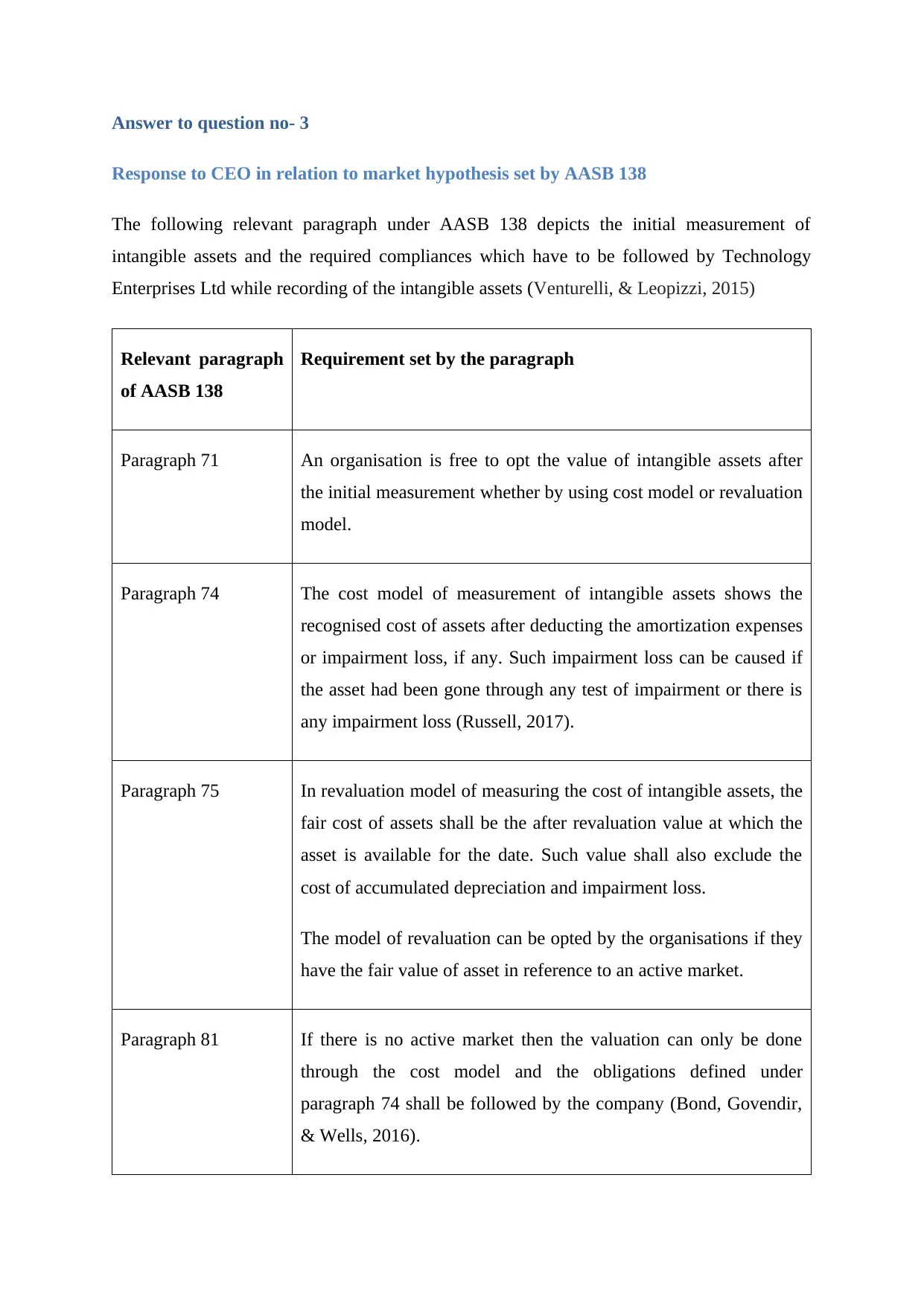
Answer to question no- 3
Response to CEO in relation to market hypothesis set by AASB 138
The following relevant paragraph under AASB 138 depicts the initial measurement of
intangible assets and the required compliances which have to be followed by Technology
Enterprises Ltd while recording of the intangible assets (Venturelli, & Leopizzi, 2015)
Relevant paragraph
of AASB 138
Requirement set by the paragraph
Paragraph 71 An organisation is free to opt the value of intangible assets after
the initial measurement whether by using cost model or revaluation
model.
Paragraph 74 The cost model of measurement of intangible assets shows the
recognised cost of assets after deducting the amortization expenses
or impairment loss, if any. Such impairment loss can be caused if
the asset had been gone through any test of impairment or there is
any impairment loss (Russell, 2017).
Paragraph 75 In revaluation model of measuring the cost of intangible assets, the
fair cost of assets shall be the after revaluation value at which the
asset is available for the date. Such value shall also exclude the
cost of accumulated depreciation and impairment loss.
The model of revaluation can be opted by the organisations if they
have the fair value of asset in reference to an active market.
Paragraph 81 If there is no active market then the valuation can only be done
through the cost model and the obligations defined under
paragraph 74 shall be followed by the company (Bond, Govendir,
& Wells, 2016).
Response to CEO in relation to market hypothesis set by AASB 138
The following relevant paragraph under AASB 138 depicts the initial measurement of
intangible assets and the required compliances which have to be followed by Technology
Enterprises Ltd while recording of the intangible assets (Venturelli, & Leopizzi, 2015)
Relevant paragraph
of AASB 138
Requirement set by the paragraph
Paragraph 71 An organisation is free to opt the value of intangible assets after
the initial measurement whether by using cost model or revaluation
model.
Paragraph 74 The cost model of measurement of intangible assets shows the
recognised cost of assets after deducting the amortization expenses
or impairment loss, if any. Such impairment loss can be caused if
the asset had been gone through any test of impairment or there is
any impairment loss (Russell, 2017).
Paragraph 75 In revaluation model of measuring the cost of intangible assets, the
fair cost of assets shall be the after revaluation value at which the
asset is available for the date. Such value shall also exclude the
cost of accumulated depreciation and impairment loss.
The model of revaluation can be opted by the organisations if they
have the fair value of asset in reference to an active market.
Paragraph 81 If there is no active market then the valuation can only be done
through the cost model and the obligations defined under
paragraph 74 shall be followed by the company (Bond, Govendir,
& Wells, 2016).
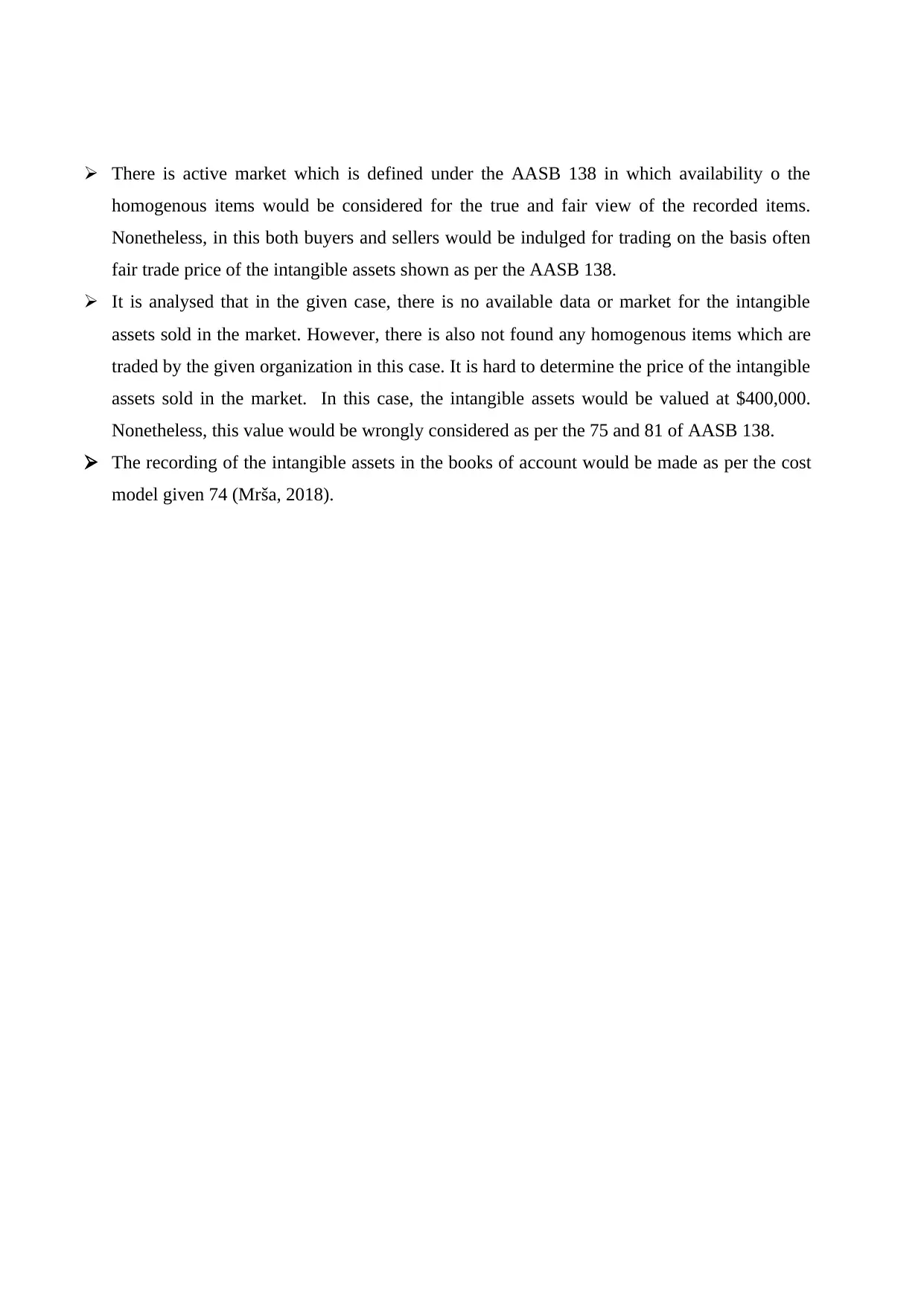
There is active market which is defined under the AASB 138 in which availability o the
homogenous items would be considered for the true and fair view of the recorded items.
Nonetheless, in this both buyers and sellers would be indulged for trading on the basis often
fair trade price of the intangible assets shown as per the AASB 138.
It is analysed that in the given case, there is no available data or market for the intangible
assets sold in the market. However, there is also not found any homogenous items which are
traded by the given organization in this case. It is hard to determine the price of the intangible
assets sold in the market. In this case, the intangible assets would be valued at $400,000.
Nonetheless, this value would be wrongly considered as per the 75 and 81 of AASB 138.
The recording of the intangible assets in the books of account would be made as per the cost
model given 74 (Mrša, 2018).
homogenous items would be considered for the true and fair view of the recorded items.
Nonetheless, in this both buyers and sellers would be indulged for trading on the basis often
fair trade price of the intangible assets shown as per the AASB 138.
It is analysed that in the given case, there is no available data or market for the intangible
assets sold in the market. However, there is also not found any homogenous items which are
traded by the given organization in this case. It is hard to determine the price of the intangible
assets sold in the market. In this case, the intangible assets would be valued at $400,000.
Nonetheless, this value would be wrongly considered as per the 75 and 81 of AASB 138.
The recording of the intangible assets in the books of account would be made as per the cost
model given 74 (Mrša, 2018).
⊘ This is a preview!⊘
Do you want full access?
Subscribe today to unlock all pages.

Trusted by 1+ million students worldwide
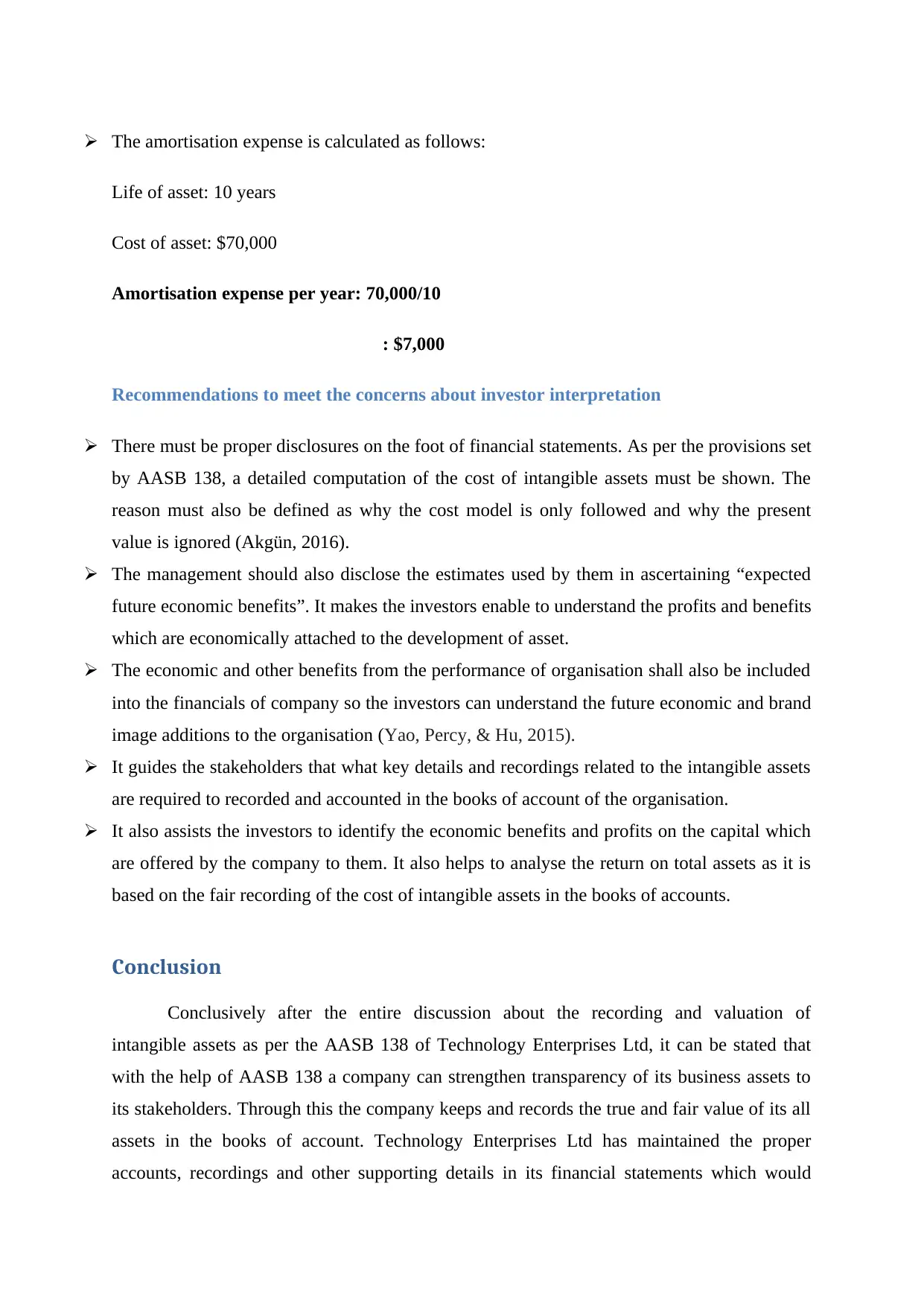
The amortisation expense is calculated as follows:
Life of asset: 10 years
Cost of asset: $70,000
Amortisation expense per year: 70,000/10
: $7,000
Recommendations to meet the concerns about investor interpretation
There must be proper disclosures on the foot of financial statements. As per the provisions set
by AASB 138, a detailed computation of the cost of intangible assets must be shown. The
reason must also be defined as why the cost model is only followed and why the present
value is ignored (Akgün, 2016).
The management should also disclose the estimates used by them in ascertaining “expected
future economic benefits”. It makes the investors enable to understand the profits and benefits
which are economically attached to the development of asset.
The economic and other benefits from the performance of organisation shall also be included
into the financials of company so the investors can understand the future economic and brand
image additions to the organisation (Yao, Percy, & Hu, 2015).
It guides the stakeholders that what key details and recordings related to the intangible assets
are required to recorded and accounted in the books of account of the organisation.
It also assists the investors to identify the economic benefits and profits on the capital which
are offered by the company to them. It also helps to analyse the return on total assets as it is
based on the fair recording of the cost of intangible assets in the books of accounts.
Conclusion
Conclusively after the entire discussion about the recording and valuation of
intangible assets as per the AASB 138 of Technology Enterprises Ltd, it can be stated that
with the help of AASB 138 a company can strengthen transparency of its business assets to
its stakeholders. Through this the company keeps and records the true and fair value of its all
assets in the books of account. Technology Enterprises Ltd has maintained the proper
accounts, recordings and other supporting details in its financial statements which would
Life of asset: 10 years
Cost of asset: $70,000
Amortisation expense per year: 70,000/10
: $7,000
Recommendations to meet the concerns about investor interpretation
There must be proper disclosures on the foot of financial statements. As per the provisions set
by AASB 138, a detailed computation of the cost of intangible assets must be shown. The
reason must also be defined as why the cost model is only followed and why the present
value is ignored (Akgün, 2016).
The management should also disclose the estimates used by them in ascertaining “expected
future economic benefits”. It makes the investors enable to understand the profits and benefits
which are economically attached to the development of asset.
The economic and other benefits from the performance of organisation shall also be included
into the financials of company so the investors can understand the future economic and brand
image additions to the organisation (Yao, Percy, & Hu, 2015).
It guides the stakeholders that what key details and recordings related to the intangible assets
are required to recorded and accounted in the books of account of the organisation.
It also assists the investors to identify the economic benefits and profits on the capital which
are offered by the company to them. It also helps to analyse the return on total assets as it is
based on the fair recording of the cost of intangible assets in the books of accounts.
Conclusion
Conclusively after the entire discussion about the recording and valuation of
intangible assets as per the AASB 138 of Technology Enterprises Ltd, it can be stated that
with the help of AASB 138 a company can strengthen transparency of its business assets to
its stakeholders. Through this the company keeps and records the true and fair value of its all
assets in the books of account. Technology Enterprises Ltd has maintained the proper
accounts, recordings and other supporting details in its financial statements which would
Paraphrase This Document
Need a fresh take? Get an instant paraphrase of this document with our AI Paraphraser
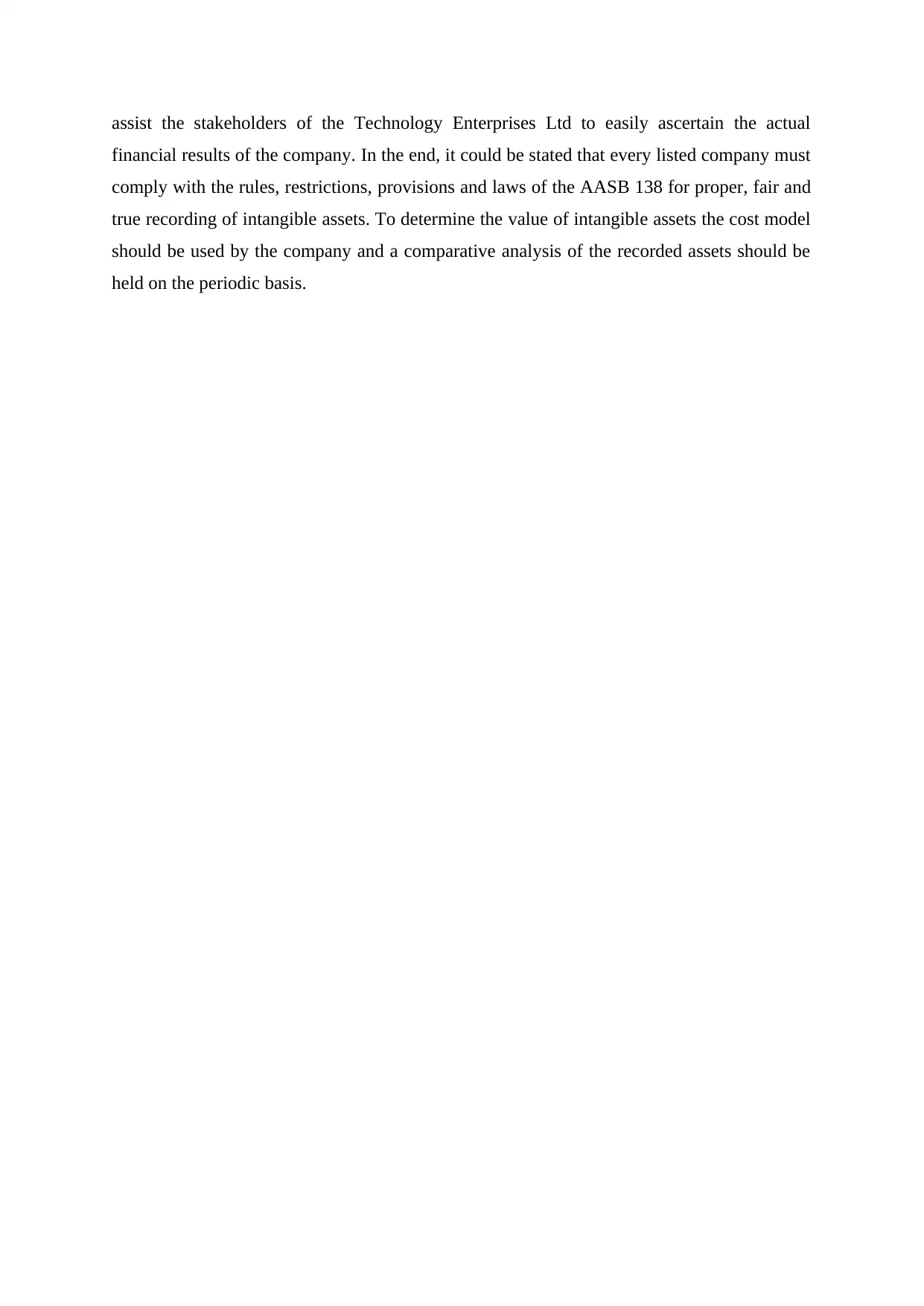
assist the stakeholders of the Technology Enterprises Ltd to easily ascertain the actual
financial results of the company. In the end, it could be stated that every listed company must
comply with the rules, restrictions, provisions and laws of the AASB 138 for proper, fair and
true recording of intangible assets. To determine the value of intangible assets the cost model
should be used by the company and a comparative analysis of the recorded assets should be
held on the periodic basis.
financial results of the company. In the end, it could be stated that every listed company must
comply with the rules, restrictions, provisions and laws of the AASB 138 for proper, fair and
true recording of intangible assets. To determine the value of intangible assets the cost model
should be used by the company and a comparative analysis of the recorded assets should be
held on the periodic basis.
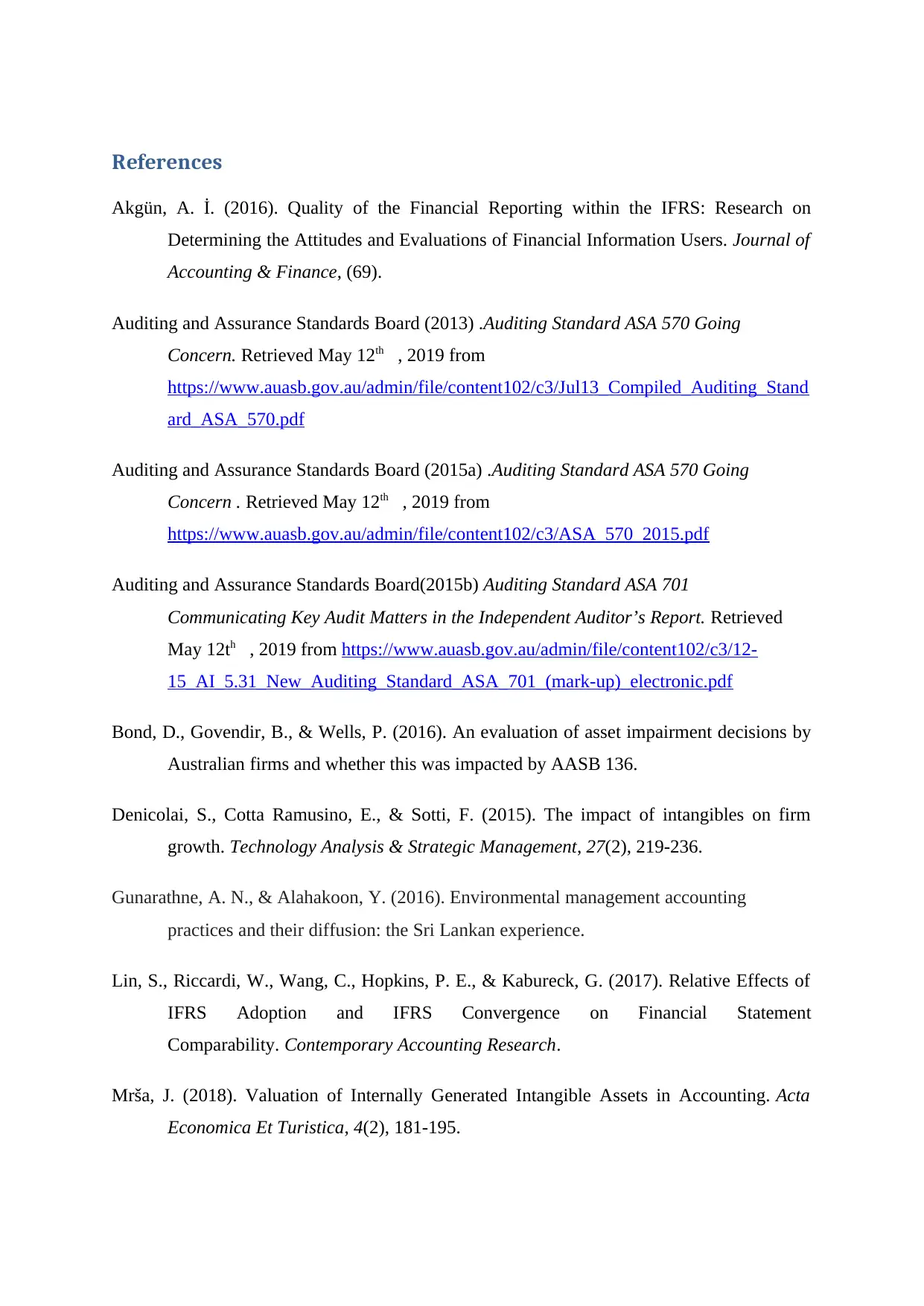
References
Akgün, A. İ. (2016). Quality of the Financial Reporting within the IFRS: Research on
Determining the Attitudes and Evaluations of Financial Information Users. Journal of
Accounting & Finance, (69).
Auditing and Assurance Standards Board (2013) .Auditing Standard ASA 570 Going
Concern. Retrieved May 12th , 2019 from
https://www.auasb.gov.au/admin/file/content102/c3/Jul13_Compiled_Auditing_Stand
ard_ASA_570.pdf
Auditing and Assurance Standards Board (2015a) .Auditing Standard ASA 570 Going
Concern . Retrieved May 12th , 2019 from
https://www.auasb.gov.au/admin/file/content102/c3/ASA_570_2015.pdf
Auditing and Assurance Standards Board(2015b) Auditing Standard ASA 701
Communicating Key Audit Matters in the Independent Auditor’s Report. Retrieved
May 12th , 2019 from https://www.auasb.gov.au/admin/file/content102/c3/12-
15_AI_5.31_New_Auditing_Standard_ASA_701_(mark-up)_electronic.pdf
Bond, D., Govendir, B., & Wells, P. (2016). An evaluation of asset impairment decisions by
Australian firms and whether this was impacted by AASB 136.
Denicolai, S., Cotta Ramusino, E., & Sotti, F. (2015). The impact of intangibles on firm
growth. Technology Analysis & Strategic Management, 27(2), 219-236.
Gunarathne, A. N., & Alahakoon, Y. (2016). Environmental management accounting
practices and their diffusion: the Sri Lankan experience.
Lin, S., Riccardi, W., Wang, C., Hopkins, P. E., & Kabureck, G. (2017). Relative Effects of
IFRS Adoption and IFRS Convergence on Financial Statement
Comparability. Contemporary Accounting Research.
Mrša, J. (2018). Valuation of Internally Generated Intangible Assets in Accounting. Acta
Economica Et Turistica, 4(2), 181-195.
Akgün, A. İ. (2016). Quality of the Financial Reporting within the IFRS: Research on
Determining the Attitudes and Evaluations of Financial Information Users. Journal of
Accounting & Finance, (69).
Auditing and Assurance Standards Board (2013) .Auditing Standard ASA 570 Going
Concern. Retrieved May 12th , 2019 from
https://www.auasb.gov.au/admin/file/content102/c3/Jul13_Compiled_Auditing_Stand
ard_ASA_570.pdf
Auditing and Assurance Standards Board (2015a) .Auditing Standard ASA 570 Going
Concern . Retrieved May 12th , 2019 from
https://www.auasb.gov.au/admin/file/content102/c3/ASA_570_2015.pdf
Auditing and Assurance Standards Board(2015b) Auditing Standard ASA 701
Communicating Key Audit Matters in the Independent Auditor’s Report. Retrieved
May 12th , 2019 from https://www.auasb.gov.au/admin/file/content102/c3/12-
15_AI_5.31_New_Auditing_Standard_ASA_701_(mark-up)_electronic.pdf
Bond, D., Govendir, B., & Wells, P. (2016). An evaluation of asset impairment decisions by
Australian firms and whether this was impacted by AASB 136.
Denicolai, S., Cotta Ramusino, E., & Sotti, F. (2015). The impact of intangibles on firm
growth. Technology Analysis & Strategic Management, 27(2), 219-236.
Gunarathne, A. N., & Alahakoon, Y. (2016). Environmental management accounting
practices and their diffusion: the Sri Lankan experience.
Lin, S., Riccardi, W., Wang, C., Hopkins, P. E., & Kabureck, G. (2017). Relative Effects of
IFRS Adoption and IFRS Convergence on Financial Statement
Comparability. Contemporary Accounting Research.
Mrša, J. (2018). Valuation of Internally Generated Intangible Assets in Accounting. Acta
Economica Et Turistica, 4(2), 181-195.
⊘ This is a preview!⊘
Do you want full access?
Subscribe today to unlock all pages.

Trusted by 1+ million students worldwide
1 out of 13
Related Documents
Your All-in-One AI-Powered Toolkit for Academic Success.
+13062052269
info@desklib.com
Available 24*7 on WhatsApp / Email
![[object Object]](/_next/static/media/star-bottom.7253800d.svg)
Unlock your academic potential
Copyright © 2020–2025 A2Z Services. All Rights Reserved. Developed and managed by ZUCOL.





